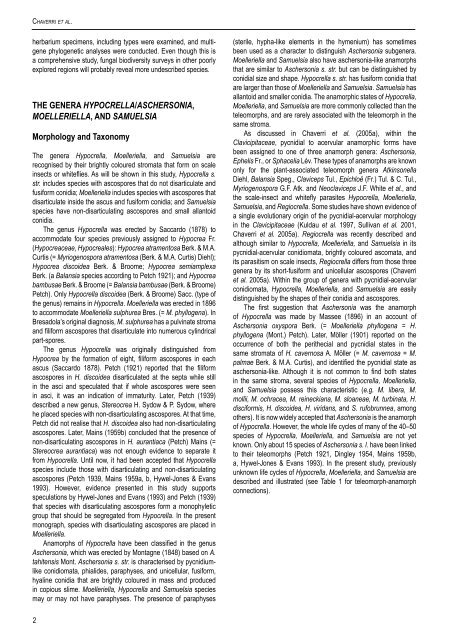Moelleriella, and Samuelsia - CBS
Moelleriella, and Samuelsia - CBS
Moelleriella, and Samuelsia - CBS
- No tags were found...
You also want an ePaper? Increase the reach of your titles
YUMPU automatically turns print PDFs into web optimized ePapers that Google loves.
Ch av e r r i e t a l.herbarium specimens, including types were examined, <strong>and</strong> multigenephylogenetic analyses were conducted. Even though this isa comprehensive study, fungal biodiversity surveys in other poorlyexplored regions will probably reveal more undescribed species.The genera Hypocrella/Aschersonia,<strong>Moelleriella</strong>, <strong>and</strong> <strong>Samuelsia</strong>Morphology <strong>and</strong> TaxonomyThe genera Hypocrella, <strong>Moelleriella</strong>, <strong>and</strong> <strong>Samuelsia</strong> arerecognised by their brightly coloured stromata that form on scaleinsects or whiteflies. As will be shown in this study, Hypocrella s.str. includes species with ascospores that do not disarticulate <strong>and</strong>fusiform conidia; <strong>Moelleriella</strong> includes species with ascospores thatdisarticulate inside the ascus <strong>and</strong> fusiform conidia; <strong>and</strong> <strong>Samuelsia</strong>species have non-disarticulating ascospores <strong>and</strong> small allantoidconidia.The genus Hypocrella was erected by Saccardo (1878) toaccommodate four species previously assigned to Hypocrea Fr.(Hypocreaceae, Hypocreales): Hypocrea atramentosa Berk. & M.A.Curtis (= Myriogenospora atramentosa (Berk. & M.A. Curtis) Diehl);Hypocrea discoidea Berk. & Broome; Hypocrea semiamplexaBerk. (a Balansia species according to Petch 1921); <strong>and</strong> Hypocreabambusae Berk. & Broome (= Balansia bambusae (Berk. & Broome)Petch). Only Hypocrella discoidea (Berk. & Broome) Sacc. (type ofthe genus) remains in Hypocrella. <strong>Moelleriella</strong> was erected in 1896to accommodate <strong>Moelleriella</strong> sulphurea Bres. (= M. phyllogena). InBresadola’s original diagnosis, M. sulphurea has a pulvinate stroma<strong>and</strong> filiform ascospores that disarticulate into numerous cylindricalpart-spores.The genus Hypocrella was originally distinguished fromHypocrea by the formation of eight, filiform ascospores in eachascus (Saccardo 1878). Petch (1921) reported that the filiformascospores in H. discoidea disarticulated at the septa while stillin the asci <strong>and</strong> speculated that if whole ascospores were seenin asci, it was an indication of immaturity. Later, Petch (1939)described a new genus, Stereocrea H. Sydow & P. Sydow, wherehe placed species with non-disarticulating ascospores. At that time,Petch did not realise that H. discoidea also had non-disarticulatingascospores. Later, Mains (1959b) concluded that the presence ofnon-disarticulating ascospores in H. aurantiaca (Petch) Mains (=Stereocrea aurantiaca) was not enough evidence to separate itfrom Hypocrella. Until now, it had been accepted that Hypocrellaspecies include those with disarticulating <strong>and</strong> non-disarticulatingascospores (Petch 1939, Mains 1959a, b, Hywel-Jones & Evans1993). However, evidence presented in this study supportsspeculations by Hywel-Jones <strong>and</strong> Evans (1993) <strong>and</strong> Petch (1939)that species with disarticulating ascospores form a monophyleticgroup that should be segregated from Hypocrella. In the presentmonograph, species with disarticulating ascospores are placed in<strong>Moelleriella</strong>.Anamorphs of Hypocrella have been classified in the genusAschersonia, which was erected by Montagne (1848) based on A.tahitensis Mont. Aschersonia s. str. is characterised by pycnidiumlikeconidiomata, phialides, paraphyses, <strong>and</strong> unicellular, fusiform,hyaline conidia that are brightly coloured in mass <strong>and</strong> producedin copious slime. <strong>Moelleriella</strong>, Hypocrella <strong>and</strong> <strong>Samuelsia</strong> speciesmay or may not have paraphyses. The presence of paraphyses(sterile, hypha-like elements in the hymenium) has sometimesbeen used as a character to distinguish Aschersonia subgenera.<strong>Moelleriella</strong> <strong>and</strong> <strong>Samuelsia</strong> also have aschersonia-like anamorphsthat are similar to Aschersonia s. str. but can be distinguished byconidial size <strong>and</strong> shape. Hypocrella s. str. has fusiform conidia thatare larger than those of <strong>Moelleriella</strong> <strong>and</strong> <strong>Samuelsia</strong>. <strong>Samuelsia</strong> hasallantoid <strong>and</strong> smaller conidia. The anamorphic states of Hypocrella,<strong>Moelleriella</strong>, <strong>and</strong> <strong>Samuelsia</strong> are more commonly collected than theteleomorphs, <strong>and</strong> are rarely associated with the teleomorph in thesame stroma.As discussed in Chaverri et al. (2005a), within theClavicipitaceae, pycnidial to acervular anamorphic forms havebeen assigned to one of three anamorph genera: Aschersonia,Ephelis Fr., or Sphacelia Lév. These types of anamorphs are knownonly for the plant-associated teleomorph genera AtkinsonellaDiehl, Balansia Speg., Claviceps Tul., Epichloë (Fr.) Tul. & C. Tul.,Myriogenospora G.F. Atk. <strong>and</strong> Neoclaviceps J.F. White et al., <strong>and</strong>the scale-insect <strong>and</strong> whitefly parasites Hypocrella, <strong>Moelleriella</strong>,<strong>Samuelsia</strong>, <strong>and</strong> Regiocrella. Some studies have shown evidence ofa single evolutionary origin of the pycnidial-acervular morphologyin the Clavicipitaceae (Kuldau et al. 1997, Sullivan et al. 2001,Chaverri et al. 2005a). Regiocrella was recently described <strong>and</strong>although similar to Hypocrella, <strong>Moelleriella</strong>, <strong>and</strong> <strong>Samuelsia</strong> in itspycnidial-acervular conidiomata, brightly coloured ascomata, <strong>and</strong>its parasitism on scale insects, Regiocrella differs from those threegenera by its short-fusiform <strong>and</strong> unicellular ascospores (Chaverriet al. 2005a). Within the group of genera with pycnidial-acervularconidiomata, Hypocrella, <strong>Moelleriella</strong>, <strong>and</strong> <strong>Samuelsia</strong> are easilydistinguished by the shapes of their conidia <strong>and</strong> ascospores.The first suggestion that Aschersonia was the anamorphof Hypocrella was made by Massee (1896) in an account ofAschersonia oxyspora Berk. (= <strong>Moelleriella</strong> phyllogena = H.phyllogena (Mont.) Petch). Later, Möller (1901) reported on theoccurrence of both the perithecial <strong>and</strong> pycnidial states in thesame stromata of H. cavernosa A. Möller (= M. cavernosa = M.palmae Berk. & M.A. Curtis), <strong>and</strong> identified the pycnidial state asaschersonia-like. Although it is not common to find both statesin the same stroma, several species of Hypocrella, <strong>Moelleriella</strong>,<strong>and</strong> <strong>Samuelsia</strong> possess this characteristic (e.g. M. libera, M.mollii, M. ochracea, M. reineckiana, M. sloaneae, M. turbinata, H.disciformis, H. discoidea, H. viridans, <strong>and</strong> S. rufobrunnea, amongothers). It is now widely accepted that Aschersonia is the anamorphof Hypocrella. However, the whole life cycles of many of the 40–50species of Hypocrella, <strong>Moelleriella</strong>, <strong>and</strong> <strong>Samuelsia</strong> are not yetknown. Only about 15 species of Aschersonia s. l. have been linkedto their teleomorphs (Petch 1921, Dingley 1954, Mains 1959b,a, Hywel-Jones & Evans 1993). In the present study, previouslyunknown life cycles of Hypocrella, <strong>Moelleriella</strong>, <strong>and</strong> <strong>Samuelsia</strong> aredescribed <strong>and</strong> illustrated (see Table 1 for teleomorph-anamorphconnections).2
















